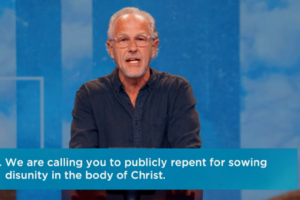Laura rapidly gained strength Wednesday, growing into a menacing Category 4 hurricane with the potential for a 20-foot storm surge that forecasters said would be “unsurvivable” and capable of sinking entire communities. Authorities implored coastal residents of Texas and Louisiana to flee.
The storm grew nearly 70% in power in just 24 hours to reach Category 3 status and continued to draw energy from the warm Gulf of Mexico waters. The system was on track to arrive late Wednesday or early Thursday as the most powerful hurricane to strike the U.S. so far this year.
“This is shaping up to be just a tremendous storm,” Louisiana Gov. John Bel Edwards told The Weather Channel.
The National Hurricane Center kept raising its estimate of Laura’s storm surge, from 10 feet just a couple of days ago to twice that size—a height that forecasters said would be especially deadly.
“Some areas, when they wake up Thursday morning, they’re not going to believe what happened,” said Stacy Stewart, a senior hurricane specialist. Whatever does not get blown down by the wind could easily be toppled by seawater pushing inland.
A Category 4 hurricane can cause damage so catastrophic that power outages may last for months in places, and wide areas could be uninhabitable for weeks or months. The threat of such devastation posed a new disaster-relief challenge for a government already straining to deal with the coronavirus pandemic.
On Wednesday afternoon, Laura had maximum sustained winds of 125 mph (205 kph) as it churned about 200 miles (320 kilometers) southeast of Lake Charles, Louisiana, and Port Arthur, Texas, traveling northwest at 16 mph (26 kmh). Those winds are expected to increase to 145 mph (233 kmh) before landfall, pushing water onto more than 450 miles (724 kilometers) of coast from Texas to Mississippi.
“Heed the advice of your local authorities. If they tell you to go, go! Your life depends on it today,” said Joel Cline, tropical program coordinator at the National Weather Service. “It’s a serious day and you need to listen to them.”
On Twitter, President Donald Trump also urged coastal residents to heed local officials. Hurricane warnings were issued from San Luis Pass, Texas, to Intracoastal City, Louisiana, and reached inland for 200 miles (322 kilometers). Storm surge warnings were in effect from Freeport, Texas, to the mouth of the Mississippi River.
In the largest U.S. evacuation during this pandemic era, more than half a million people were ordered to flee from their homes near the Texas-Louisiana state line, including the Texas cities of Beaumont, Galveston and Port Arthur, and the low-lying Calcasieu and Cameron parishes in southwestern Louisiana, where forecasters said storm surge topped by waves could submerge entire towns.
A National Weather Service meteorologist in Lake Charles, Louisiana—in the bullseye of Laura’s projected path—took to Facebook Live to deliver an urgent warning for people living south of Interstate 10 in southwest Louisiana and southeast Texas.
“Your life will be in immediate and grave danger beginning this evening if you do not evacuate,” Donald Jones said.
Laura is expected to dump massive rainfall as it moves inland, causing widespread flash flooding in states far from the coast. Flood watches were issued for much of Arkansas, and forecasters said heavy rainfall could arrive by Friday in parts of Missouri, Tennessee and Kentucky. Laura is so powerful that it’s expected to become a tropical storm again once it reaches the Atlantic Ocean, potentially menacing the Northeast.
Edwards said evacuees need to reach safety by noon Wednesday, before high winds make highway travel unsafe. In Galveston and Port Arthur, many people boarded buses to Austin and other inland cities.
But even before dawn Wednesday, officials in Austin said the city had run out of free hotel rooms to offer evacuees and had begun directing families fleeing the storm to a shelter nearly 200 miles farther north. In Texas’ Hardin County, which has more than 57,000 residents along the coast, officials warned that anyone who tried riding out the storm faced days or weeks without electricity.
“It could be difficult for some people to make it through this storm,” Texas Gov. Greg Abbott told The Weather Channel.
Officials urged people to stay with relatives or in hotels to avoid spreading the virus that causes COVID-19. Buses were stocked with protective equipment and disinfectant, and they would carry fewer passengers to keep people apart, Texas officials said. {eoa}
© 2020 The Associated Press. All rights reserved.
See an error in this article?
To contact us or to submit an article





















